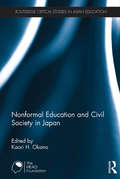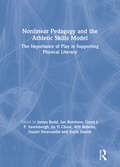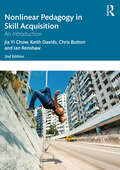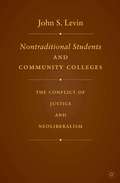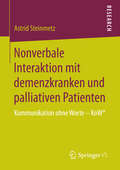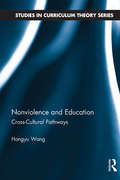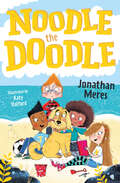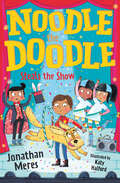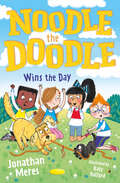- Table View
- List View
Nonfiction Notebooks: Strategies for Informational Writing
by Aimee BucknerIn my classroom, I have found that through the support of notebook work, students can grow their writing and strengthen their ideas. With strong ideas, they can write better first drafts. The work we do in notebooks before rushing into a draft gives us time to envision our work, to find mentor texts we love, and to study those texts. In doing so, we actually are doing a lot of the revision- on our vision- before we write the draft. -; Nonfiction Notebooks Aimee Buckner has introduced writer's notebooks to hundreds of classrooms through her popular book Notebook Know-How , thereby helping students everywhere learn to improve their overallwriting by focusing on essential prewriting strategies. Now, using the same format, Aimee explains how writer's notebooks can help students improve their nonfiction writing-;reports, articles, memoirs, essays, and so forth-;which has taken on even greater importance because of the emphasis the Common Core State Standards place on informative/explanatory writing. As Aimee explains, the prewriting work a student does is particularly important when writing informational pieces. Writer's notebooks help students capture their thoughts, develop ideas, explore mentor texts, refine a research strategy, and play with multiple outcomes-;all of which lead to stronger concepts and better first drafts. Greater emphasis on the front end of the writing process also saves time and energy at the revision and editing stages. From exploring topics to gathering information to assessment, Nonfiction Notebooks takes teachers step-by-step through the process of how best to use notebooks for informational writing. Helpful reproducible forms are included both in the book and as downloads online.
Nonfiction Strategies That Work: Do This--Not That!
by Lori G. WilfongTeachers are being bombarded with ideas for teaching nonfiction, but what really works? In this essential book, dynamic author Lori G. Wilfong describes ten best practices for teaching nonfiction and how to implement them in the classroom. She also points out practices that should be avoided, helping you figure out which strategies to ditch and which to embrace. Topics covered include… Finding quality, differentiated texts to teach content Selecting support strategies with purpose Providing students with a range of scaffolds for effective summary writing Purposely selecting vocabulary words to support content learning Working with students to develop strategies to cite textual evidence Using text structure as both a reading and writing tool for analyzing nonfiction And much more! Every chapter begins with an engaging scenario and ends with action steps to help you get started. The book also contains tons of handy templates that you can reproduce and use in your own classroom.
Nonfiction Strategies That Work: Do This--Not That!
by Lori G. WilfongTeachers are being bombarded with ideas for teaching nonfiction, but what really works? In this essential book, dynamic author Lori G. Wilfong describes ten best practices for teaching nonfiction and how to implement them in the classroom. She also points out practices that should be avoided, helping you figure out which strategies to ditch and which to embrace. Topics covered include… Finding quality, differentiated texts to teach content Selecting support strategies with purpose Providing students with a range of scaffolds for effective summary writing Purposely selecting vocabulary words to support content learning Working with students to develop strategies to cite textual evidence Using text structure as both a reading and writing tool for analyzing nonfiction And much more! Every chapter begins with an engaging scenario and ends with action steps to help you get started. The book also contains tons of handy templates that you can reproduce and use in your own classroom.
Nonformal Education and Civil Society in Japan (Routledge Critical Studies in Asian Education)
by Kaori H. OkanoNonformal Education and Civil Society in Japan critically examines an aspect of education that has received little attention to date: intentional teaching and learning activities that occur outside formal schooling. In the last two decades nonformal education has rapidly increased in extent and significance. This is because individual needs for education have become so diverse and rapidly changing that formal education alone is unable to satisfy them. Increasingly diverse demands on education resulted from a combination of transnational migration, heightened human rights awareness, the aging population, and competition in the globalised labour market. Some in the private sector saw this situation as a business opportunity. Others in the civil society volunteered to assist the vulnerable. The rise in nonformal education has also been facilitated by national policy developments since the 1990s. Drawing on case studies, this book illuminates a diverse range of nonformal education activities; and suggests that the nature of the relationship between nonformal education and mainstream schooling has changed. Not only have the two sectors become more interdependent, but the formal education sector increasingly acknowledges nonformal education’s important and necessary roles. These changes signal a significant departure from the past in the overall functioning of Japanese education. The case studies include: neighbourhood homework clubs for migrant children, community-based literacy classes, after-school care programs, sport clubs, alternative schools for long-term absent students, schools for foreigners, training in intercultural competence at universities and corporations, kôminkan (community halls), and lifelong learning for the seniors. This book will appeal to both scholars of Japanese Studies/Asian Studies, and those of comparative education and sociology/anthropology of education.
Nonformal Education and Civil Society in Japan (Routledge Critical Studies in Asian Education)
by Kaori H. OkanoNonformal Education and Civil Society in Japan critically examines an aspect of education that has received little attention to date: intentional teaching and learning activities that occur outside formal schooling. In the last two decades nonformal education has rapidly increased in extent and significance. This is because individual needs for education have become so diverse and rapidly changing that formal education alone is unable to satisfy them. Increasingly diverse demands on education resulted from a combination of transnational migration, heightened human rights awareness, the aging population, and competition in the globalised labour market. Some in the private sector saw this situation as a business opportunity. Others in the civil society volunteered to assist the vulnerable. The rise in nonformal education has also been facilitated by national policy developments since the 1990s. Drawing on case studies, this book illuminates a diverse range of nonformal education activities; and suggests that the nature of the relationship between nonformal education and mainstream schooling has changed. Not only have the two sectors become more interdependent, but the formal education sector increasingly acknowledges nonformal education’s important and necessary roles. These changes signal a significant departure from the past in the overall functioning of Japanese education. The case studies include: neighbourhood homework clubs for migrant children, community-based literacy classes, after-school care programs, sport clubs, alternative schools for long-term absent students, schools for foreigners, training in intercultural competence at universities and corporations, kôminkan (community halls), and lifelong learning for the seniors. This book will appeal to both scholars of Japanese Studies/Asian Studies, and those of comparative education and sociology/anthropology of education.
Nonlinear Pedagogy and the Athletic Skills Model: The Importance of Play in Supporting Physical Literacy
by James Rudd Ian Renshaw Geert Savelsbergh Jia Yi Chow Will Roberts Daniel Newcombe Keith DavidsThis book offers an ecological conceptualisation of physical literacy. Re-embracing our ancestry as hunter gatherers we gain a new appreciation and understanding of the importance of play, not only in terms of how children learn, but also in showing us as educators how we can lay the foundations for lifelong physical activity. The concept of physical literacy has been recognised and understood throughout history by different communities across the globe. Today, as governments grapple with the multiple challenges of urban life in the 21st century, we can learn from our forebears how to put play at the centre of children’s learning in order to build a more enduring physically active society. This book examines contemporary pedagogical approaches, such as constraints-led teaching, nonlinear pedagogy and the athletic skills model, which are underpinned by the theoretical framework of Ecological Dynamics. It is suggested that through careful design, these models, aimed at children, as well as young athletes, can (i) encourage play and facilitate physical activity and motor learning in children of different ages, providing them with the foundational skills needed for leading active lives; and (ii), develop young athletes in elite sports programmes in an ethical, enriching and supportive manner. Through this text, scientists, academics and practitioners in the sub-disciplines of motor learning and motor development, physical education, sports pedagogy and physical activity and exercise domains will better understand how to design programmes that encourage play and thereby develop the movement skills, self-regulating capacities, motivation and proficiency of people, so that they can move skilfully, effectively and efficiently while negotiating changes throughout the human lifespan.
Nonlinear Pedagogy and the Athletic Skills Model: The Importance of Play in Supporting Physical Literacy
by James Rudd Ian Renshaw Geert Savelsbergh Jia Yi Chow Will Roberts Daniel Newcombe Keith DavidsThis book offers an ecological conceptualisation of physical literacy. Re-embracing our ancestry as hunter gatherers we gain a new appreciation and understanding of the importance of play, not only in terms of how children learn, but also in showing us as educators how we can lay the foundations for lifelong physical activity. The concept of physical literacy has been recognised and understood throughout history by different communities across the globe. Today, as governments grapple with the multiple challenges of urban life in the 21st century, we can learn from our forebears how to put play at the centre of children’s learning in order to build a more enduring physically active society. This book examines contemporary pedagogical approaches, such as constraints-led teaching, nonlinear pedagogy and the athletic skills model, which are underpinned by the theoretical framework of Ecological Dynamics. It is suggested that through careful design, these models, aimed at children, as well as young athletes, can (i) encourage play and facilitate physical activity and motor learning in children of different ages, providing them with the foundational skills needed for leading active lives; and (ii), develop young athletes in elite sports programmes in an ethical, enriching and supportive manner. Through this text, scientists, academics and practitioners in the sub-disciplines of motor learning and motor development, physical education, sports pedagogy and physical activity and exercise domains will better understand how to design programmes that encourage play and thereby develop the movement skills, self-regulating capacities, motivation and proficiency of people, so that they can move skilfully, effectively and efficiently while negotiating changes throughout the human lifespan.
Nonlinear Pedagogy in Skill Acquisition: An Introduction
by Jia Yi Chow Keith Davids Chris Button Ian RenshawNonlinear Pedagogy is a powerful paradigm for understanding human movement and for designing effective teaching, coaching and training programmes in sport, exercise and physical education (PE). It addresses the inherent complexity in learning movement skills, viewing the learner, the learning environment and the teacher or coach as a complex interacting system. The constraints of individual practice tasks provide the platform for functional movement behaviours to emerge during practice and performance. The second edition includes new materials, of practical, theoretical and empirical relevance, to enhance understanding of how to implement a Nonlinear Pedagogy to support learning in sport, PE and physical activity. There is updated, in-depth discussion on the various pedagogical principles that support Nonlinear Pedagogy and how these principles are applicable in learning designs in sports and physical education. There is further emphasis on examining how transfer of learning is implicated in practice, highlighting its relevance on skill adaptation and talent development. The first part of the book updates the general theoretical framework to explain processes of skill acquisition and motor learning. This edition draws clearer links between skill acquisition, expertise and talent development, focusing on how specificity and generality of transfer have a role to play in the development of learners. The book defines Nonlinear Pedagogy and outlines its key principles of practice. It offers a thorough and critical appraisal of the functional use of instructional constraints and practice design. It discusses methods for creating challenging and supportive individualised learning environments at developmental, sub-elite and elite levels of performance. The second part focuses on the application of Nonlinear Pedagogy in sports and PE. There is a greater emphasis on helping applied scientists and practitioners understand the impact of Nonlinear Pedagogy on transfer of learning. Every chapter is updated to provide relevant contemporary cases and examples from sport and exercise contexts, providing guidance on practice activities and lessons. Nonlinear Pedagogy in Skill Acquisition is an essential companion for any degree-level course in skill acquisition, motor learning, sport science, sport pedagogy, sports coaching practice, or pedagogy or curriculum design in physical education.
Nonlinear Pedagogy in Skill Acquisition: An Introduction
by Jia Yi Chow Keith Davids Chris Button Ian RenshawNonlinear Pedagogy is a powerful paradigm for understanding human movement and for designing effective teaching, coaching and training programmes in sport, exercise and physical education (PE). It addresses the inherent complexity in learning movement skills, viewing the learner, the learning environment and the teacher or coach as a complex interacting system. The constraints of individual practice tasks provide the platform for functional movement behaviours to emerge during practice and performance. The second edition includes new materials, of practical, theoretical and empirical relevance, to enhance understanding of how to implement a Nonlinear Pedagogy to support learning in sport, PE and physical activity. There is updated, in-depth discussion on the various pedagogical principles that support Nonlinear Pedagogy and how these principles are applicable in learning designs in sports and physical education. There is further emphasis on examining how transfer of learning is implicated in practice, highlighting its relevance on skill adaptation and talent development. The first part of the book updates the general theoretical framework to explain processes of skill acquisition and motor learning. This edition draws clearer links between skill acquisition, expertise and talent development, focusing on how specificity and generality of transfer have a role to play in the development of learners. The book defines Nonlinear Pedagogy and outlines its key principles of practice. It offers a thorough and critical appraisal of the functional use of instructional constraints and practice design. It discusses methods for creating challenging and supportive individualised learning environments at developmental, sub-elite and elite levels of performance. The second part focuses on the application of Nonlinear Pedagogy in sports and PE. There is a greater emphasis on helping applied scientists and practitioners understand the impact of Nonlinear Pedagogy on transfer of learning. Every chapter is updated to provide relevant contemporary cases and examples from sport and exercise contexts, providing guidance on practice activities and lessons. Nonlinear Pedagogy in Skill Acquisition is an essential companion for any degree-level course in skill acquisition, motor learning, sport science, sport pedagogy, sports coaching practice, or pedagogy or curriculum design in physical education.
Nonlinear Pedagogy in Skill Acquisition: An Introduction
by Ian Renshaw Keith Davids Jia Yi Chow Chris ButtonNonlinear pedagogy is a powerful paradigm for understanding human movement and for designing effective teaching, coaching and training programs in sport, exercise and physical education. It addresses the inherent complexity in the learning of movement skills, viewing the learner, the learning environment and the teacher or coach as a complex interacting system, with the constraints of individual practice tasks providing the platform for functional movement behaviours to emerge. This is the first book to explain this profoundly important new approach to skill acquisition, introducing key theoretical ideas and best practice for students, teachers and coaches. The first section of the book offers a general theoretical framework to explain processes of skill acquisition and the learning of movement skills. The book then defines nonlinear pedagogy, and outlines its key principles of practice. It offers a thorough and critical appraisal of the optimal use of instructional constraints and practice design, and discusses methods for creating challenging and supportive individualised learning environments at developmental, sub-elite and elite levels of performance. Every chapter contains cases and examples from sport and exercise contexts, providing guidance on practice activities and lessons. Nonlinear Pedagogy in Skill Acquisition is an essential companion for any degree level course in skill acquisition, motor learning, sport science, sport pedagogy, sports coaching practice, or pedagogy or curriculum design in physical education.
Nonlinear Pedagogy in Skill Acquisition: An Introduction
by Ian Renshaw Keith Davids Jia Yi Chow Chris ButtonNonlinear pedagogy is a powerful paradigm for understanding human movement and for designing effective teaching, coaching and training programs in sport, exercise and physical education. It addresses the inherent complexity in the learning of movement skills, viewing the learner, the learning environment and the teacher or coach as a complex interacting system, with the constraints of individual practice tasks providing the platform for functional movement behaviours to emerge. This is the first book to explain this profoundly important new approach to skill acquisition, introducing key theoretical ideas and best practice for students, teachers and coaches. The first section of the book offers a general theoretical framework to explain processes of skill acquisition and the learning of movement skills. The book then defines nonlinear pedagogy, and outlines its key principles of practice. It offers a thorough and critical appraisal of the optimal use of instructional constraints and practice design, and discusses methods for creating challenging and supportive individualised learning environments at developmental, sub-elite and elite levels of performance. Every chapter contains cases and examples from sport and exercise contexts, providing guidance on practice activities and lessons. Nonlinear Pedagogy in Skill Acquisition is an essential companion for any degree level course in skill acquisition, motor learning, sport science, sport pedagogy, sports coaching practice, or pedagogy or curriculum design in physical education.
Nonlinear Second Order Parabolic Equations
by Mingxin WangThe parabolic partial differential equations model one of the most important processes in the real-world: diffusion. Whether it is the diffusion of energy in space-time, the diffusion of species in ecology, the diffusion of chemicals in biochemical processes, or the diffusion of information in social networks, diffusion processes are ubiquitous and crucial in the physical and natural world as well as our everyday lives. This book is self-contained and covers key topics such as theory and Schauder theory, maximum principle, comparison principle, regularity and uniform estimates, initial-boundary value problems of semilinear parabolic scalar equations and weakly coupled parabolic systems, the upper and lower solutions method, monotone properties and long-time behaviours of solutions, convergence of solutions and stability of equilibrium solutions, global solutions and finite time blowup. It also touches on periodic boundary value problems, free boundary problems, and semigroup theory. The book covers major theories and methods of the field, including topics that are useful but hard to find elsewhere. This book is based on tried and tested teaching materials used at the Harbin Institute of Technology over the past ten years. Special care was taken to make the book suitable for classroom teaching as well as for self-study among graduate students. About the Author: Mingxin Wang is Professor of Mathematics at Harbin Institute of Technology, China. He has published ten monographs and textbooks and 260 papers. He is also a supervisor of 30 PhD students.
Nonlinear Second Order Parabolic Equations
by Mingxin WangThe parabolic partial differential equations model one of the most important processes in the real-world: diffusion. Whether it is the diffusion of energy in space-time, the diffusion of species in ecology, the diffusion of chemicals in biochemical processes, or the diffusion of information in social networks, diffusion processes are ubiquitous and crucial in the physical and natural world as well as our everyday lives. This book is self-contained and covers key topics such as theory and Schauder theory, maximum principle, comparison principle, regularity and uniform estimates, initial-boundary value problems of semilinear parabolic scalar equations and weakly coupled parabolic systems, the upper and lower solutions method, monotone properties and long-time behaviours of solutions, convergence of solutions and stability of equilibrium solutions, global solutions and finite time blowup. It also touches on periodic boundary value problems, free boundary problems, and semigroup theory. The book covers major theories and methods of the field, including topics that are useful but hard to find elsewhere. This book is based on tried and tested teaching materials used at the Harbin Institute of Technology over the past ten years. Special care was taken to make the book suitable for classroom teaching as well as for self-study among graduate students. About the Author: Mingxin Wang is Professor of Mathematics at Harbin Institute of Technology, China. He has published ten monographs and textbooks and 260 papers. He is also a supervisor of 30 PhD students.
Nonnative Speaker English Teachers: Research, Pedagogy, and Professional Growth (ESL & Applied Linguistics Professional Series)
by George BraineAccording to current estimates, about eighty percent of English teachers worldwide are nonnative speakers of the language. The nonnative speaker movement began a decade ago to counter the discrimination faced by these teachers and to champion their causes. As the first single-authored volume on the topic since the birth of the movement, this book fills the need for a coherent account that: traces the origins and growth of the movement summarizes the research that has been conducted highlights the challenges faced by nonnative speaker teachers promotes NNS teachers’ professional growth. No discussion of world Englishes or the spread of English internationally is now complete without reference to the NNS movement. This book celebrates its first decade and charts a direction for its growth and development.
Nonnative Speaker English Teachers: Research, Pedagogy, and Professional Growth (ESL & Applied Linguistics Professional Series)
by George BraineAccording to current estimates, about eighty percent of English teachers worldwide are nonnative speakers of the language. The nonnative speaker movement began a decade ago to counter the discrimination faced by these teachers and to champion their causes. As the first single-authored volume on the topic since the birth of the movement, this book fills the need for a coherent account that: traces the origins and growth of the movement summarizes the research that has been conducted highlights the challenges faced by nonnative speaker teachers promotes NNS teachers’ professional growth. No discussion of world Englishes or the spread of English internationally is now complete without reference to the NNS movement. This book celebrates its first decade and charts a direction for its growth and development.
Nonstandard Notebook: Mathematically Ruled Pages for Unruly Thoughts
by Tim Chartier Amy LangvilleA revolutionary notebook that challenges us to play outside (and with) the lines. A standard notebook displays page after page of horizontal lines. But what if we break the pattern? What if the ruled pages grew unruly? In this Nonstandard Notebook, lines twist, fragment, curve, and crisscross in beautiful formations. Each sheet is a distinctive work of imagination, asking us to draw, doodle, and journal in the same spirit. Page after page, as we journey from lines to parabolas to waves, deep questions arise—about form, art, and mathematics. How do we harness the infinite? Why do patterns permeate nature? What are the limitations and possibilities of human vision? Nonstandard Notebook explores these questions and more through its provocative and inspirational images, each displayed with the mathematics that generated it. We see how straight lines can form fractal crenellations, how circles can disrupt and unify, and how waves and scaling can form complex landscapes (or even famous faces). Created by mathematicians, educators, and math popularizers Tim Chartier and Amy Langville, and with a foreword from Ben Orlin (bestselling author of Math with Bad Drawings), Nonstandard Notebook shows that rules—both the rules of mathematics and the rules of a notebook—do not mark the end of creativity, but the beginning.
Nontraditional Students and Community Colleges: The Conflict of Justice and Neoliberalism
by J. LevinFocusing on non-traditional students in higher education institutions, this new book from renowned scholar John Levin examines the extent to which community college students receive justice both within their institution and as an outcome of their education.
Nonverbal Delivery in Speaking Assessment: From An Argument to A Rating Scale Formulation and Validation
by Mingwei PanWith an argument for embedding nonverbal delivery in speaking assessment as a point of departure, this book seeks to validate a proposed rating scale for incorporating nonverbal delivery and other conventional dimensions into speaking assessment with a mixed-methods approach. To illustrate the indispensable role of nonverbal delivery in speaking assessment, the book particularly includes snapshots of test-takers’ de facto nonverbal delivery, which allow their respective levels to be investigated in a microscopic manner.
Nonverbal Learning Disabilities in Children: Bridging the Gap Between Science and Practice
by John M. Davis Jessica BroitmanAlthough it has yet to be recognized by the American Psychiatric Association’s Diagnostic and Statistical Manual (DSM), nonverbal learning disabilities (NVLD) in children are a growing concern. NVLD are receiving increased attention from researchers as well as from clinicians encountering these conditions in their young clients. At the same time, reliable information on effective interventions for NVLD has lagged behind this interest.Nonverbal Learning Disabilities in Children: Bridging the Gap Between Science and Practice offers a well-rounded understanding of NVLD, placing it within the context of other developmental disorders, most notably high-functioning autism and Asperger’s syndrome. The most current genetic, environmental, and neurobiological theories of and research into the causes of NVLD (e.g., the “white matter model”), in-depth diagnostic methods, and quality interventions are examined. Using an evidence-based approach, this groundbreaking volume:Conceptualizes NVLD as a disorder with subtypes. Differentiates between diagnostic criteria for NVLD and Asperger’s Syndrome. Analyzes the co-occurrence of NVLD with other developmental disabilities and psychological disorders.Provides a comprehensive psychoeducational assessment model.Describes efficacious treatments and supports their empirical validation. Offers guidelines for sustaining treatment gains through effective collaboration of school personnel and family members.Nonverbal Learning Disabilities in Children is a must-have reference for researchers, practitioners, and graduate students in school and clinical child psychology, education, speech-language therapy, and other disciplines and professions involved in identifying and treating children with NVLD.
Nonverbale Interaktion mit demenzkranken und palliativen Patienten: Kommunikation ohne Worte – KoW®
by Astrid SteinmetzDas Buch befasst sich mit der Situation demenzkranker wie palliativer Patienten, insbesondere mit deren Veränderungen hinsichtlich sprachlicher Interaktionsfähigkeiten. Die Autorin legt dar, dass es für den Erhalt einer dialogischen Patientenbeziehung erforderlich ist, den Fokus auf nonverbale Kommunikationsmöglichkeiten zu verschieben. Das dafür entwickelte Trainingsprogramm "Kommunikation ohne Worte" (KoW®) wird erläutert und evaluiert. Darin werden interpersonelle Kommunikationsfertigkeiten mit dem kommunikativ schwer eingeschränkten Menschen vermittelt, um Emotionen, Bedürfnisse oder Schmerzen sicher zu erkennen, sich nonverbal abzustimmen sowie eindeutig und verständlich zu kommunizieren.
Nonviolence and Education: Cross-Cultural Pathways (Studies in Curriculum Theory Series)
by Hongyu WangIn current global politics, which positions China as a competitor to American leadership, in-depth understandings of transnational mutual engagement are much needed for cultivating nonviolent relations. Exploring American and Chinese professors’ experiences at the intersection of the individual, society, and history, and weaving the autobiographical and the global, this book furthers understanding of their cross-cultural personal awareness and educational work at universities in both countries. While focusing on life histories, it also draws on both American and Chinese intellectual traditions such as American nonviolence activism, Taoism, and Buddhism to formulate a vision of nonviolence in curriculum studies. Centering cross-cultural education and pedagogy about, for, and through nonviolence, this volume contributes to internationalizing curriculum studies and introduces curriculum theorizing at the level of higher education. Hongyu Wang brings together stories, dialogues, and juxtapositions of cross-cultural pathways and pedagogies in a powerful case for theorizing and performing nonviolence education as visionary work in the internationalization of curriculum studies.
Nonviolence and Education: Cross-Cultural Pathways (Studies in Curriculum Theory Series)
by Hongyu WangIn current global politics, which positions China as a competitor to American leadership, in-depth understandings of transnational mutual engagement are much needed for cultivating nonviolent relations. Exploring American and Chinese professors’ experiences at the intersection of the individual, society, and history, and weaving the autobiographical and the global, this book furthers understanding of their cross-cultural personal awareness and educational work at universities in both countries. While focusing on life histories, it also draws on both American and Chinese intellectual traditions such as American nonviolence activism, Taoism, and Buddhism to formulate a vision of nonviolence in curriculum studies. Centering cross-cultural education and pedagogy about, for, and through nonviolence, this volume contributes to internationalizing curriculum studies and introduces curriculum theorizing at the level of higher education. Hongyu Wang brings together stories, dialogues, and juxtapositions of cross-cultural pathways and pedagogies in a powerful case for theorizing and performing nonviolence education as visionary work in the internationalization of curriculum studies.
Noodle the Doodle (Noodle the Doodle #1)
by Jonathan MeresChaos ensues when an excitable rescue dog becomes the newest member of the class in this touching tale from bestselling author Jonathan Meres. Particularly suitable for struggling, reluctant or dyslexic readers aged 8+
Noodle the Doodle (Noodle the Doodle #2)
by Jonathan MeresThere's a new kid joining the class at Wigley primary but can Noodle the doodle help him prepare for the school talent show? Mishaps and mayhem abound as Jonathan Meres returns with an adorable canine comedy.
Noodle the Doodle (Noodle the Doodle #3)
by Jonathan MeresIt’s Sports Day at Wigley Primary and everyone is excited to take part, including the school’s special pooch, Noodle the Doodle! A charming third serving of fun from bestseller Jonathan Meres.


